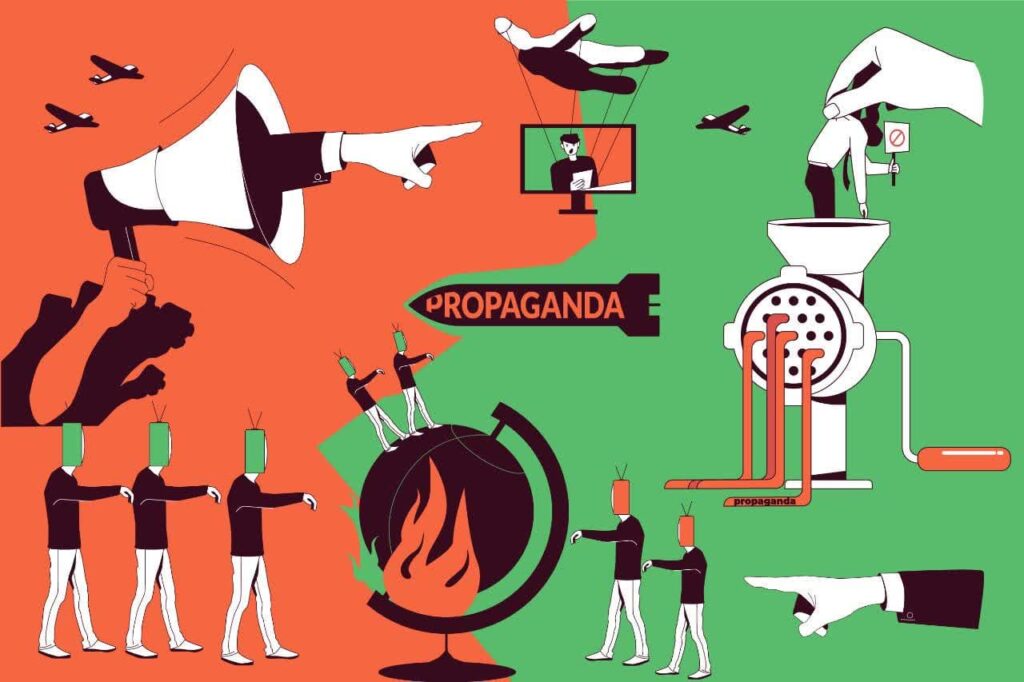Propaganda, a powerful force ingrained in the annals of human history, remains as relevant today as ever, seamlessly adapting to the changing tides of communication. This detailed exploration aims to unravel the complex layers of propaganda, from its historical roots to its modern manifestations, highlighting the profound impact it continues to have on societies and individuals.
Historical Roots
The roots of propaganda can be traced back to ancient civilizations, where rulers and leaders utilized various forms of communication to influence public perception. However, it gained prominence in the 20th century, particularly during times of war and political upheaval. Propaganda became a strategic tool for governments to control narratives, unite populations, and manipulate public sentiment.
Mechanisms and Strategies
Propaganda operates through a myriad of mechanisms, encompassing media, education, art, and even language. It thrives on shaping narratives, constructing symbols, and framing issues in a way that aligns with specific agendas. In the contemporary landscape, the digital era has introduced new avenues for propaganda, utilizing social media, targeted advertising, and algorithmic manipulation to disseminate information swiftly and broadly.
The Digital Age
Social media platforms, with their global reach and real-time nature, have become fertile ground for propagandistic efforts. The viral spread of information, often without proper verification, allows propaganda to infiltrate public consciousness rapidly. From state-sponsored campaigns to fringe ideologies, the digital age has ushered in a new era where propaganda can be disseminated with unprecedented speed and efficiency.

Psychological Impact
Propaganda operates not only on an informational level but also on a psychological one. It leverages cognitive biases, emotional triggers, and the human tendency to conform to societal norms. By manipulating these psychological aspects, propaganda seeks to shape perceptions, influence behaviors, and even alter collective memories.
Catering to the Challenge
Addressing the pervasive challenge of propaganda demands a multifaceted approach that combines education, media literacy, and collective vigilance. Firstly, integrating comprehensive media literacy programs into educational curricula at various levels becomes essential. By teaching students how to critically analyze information, discern bias, and understand the mechanics of propaganda, we empower the next generation with the tools to navigate the intricate landscape of contemporary communication.

Secondly, fostering a culture of transparency and accountability within media outlets and digital platforms is paramount. Media organizations should prioritize fact-checking, ethical reporting, and providing diverse perspectives. Collaborative efforts between tech companies, governments, and civil society can work towards creating algorithms that prioritize accuracy and diversity of sources, mitigating the potential amplification of propagandistic content. Additionally, empowering individuals with tools to fact-check and critically evaluate information in real-time can contribute to a more informed and discerning public. By promoting a collective commitment to media literacy and ethical journalism, societies can build resilient defenses against the insidious influence of propaganda, allowing for a more informed and democratic discourse.
Real-Time Examples of Propaganda Usage and Themes
COVID-19 Misinformation Campaigns
Throughout the global COVID-19 pandemic, various instances of propaganda have emerged, disseminating misleading information on the virus’s origin, spread, and potential cures. State-sponsored campaigns and conspiracy theories have exploited the uncertainty surrounding the pandemic, aiming to create confusion, manipulate public perceptions, and undermine trust in institutions. Concepts such as vaccine hesitancy and the politicization of public health measures have been fueled by propagandistic efforts, impacting global responses to the crisis.
Election Interference and Disinformation
Elections worldwide have become hotbeds for propaganda, with state and non-state actors leveraging misinformation to influence voter behavior. Real-time examples include allegations of foreign interference in elections through social media manipulation, the spread of false narratives about candidates, and the amplification of divisive issues to sow discord. Propaganda in the context of elections often revolves around themes of fear, identity, and polarization, aiming to sway public opinion and disrupt the democratic process.
Climate Change Denial Campaigns
Propaganda has also been employed to shape narratives around environmental issues, with climate change denial campaigns being a notable example. Various interest groups, often linked to industries with environmental implications, have propagated misinformation to downplay the severity of climate change or cast doubt on the scientific consensus. Themes such as economic impact, skepticism about scientific findings, and the questioning of climate change urgency have been central to these propagandistic efforts, influencing public discourse and policy decisions.
These real-time examples underscore the diverse themes around which propaganda operates, demonstrating its adaptability to exploit contemporary issues and manipulate public perceptions for various motives.
Conclusion
In conclusion, the pervasive nature of propaganda serves as a reminder that, in our interconnected world, none of us are entirely immune to its influential currents. Understanding its historical context, mechanisms, and psychological impact equips us to approach information with a more discerning mindset, fostering a society that values critical thinking and media literacy in the face of persuasive narratives.

